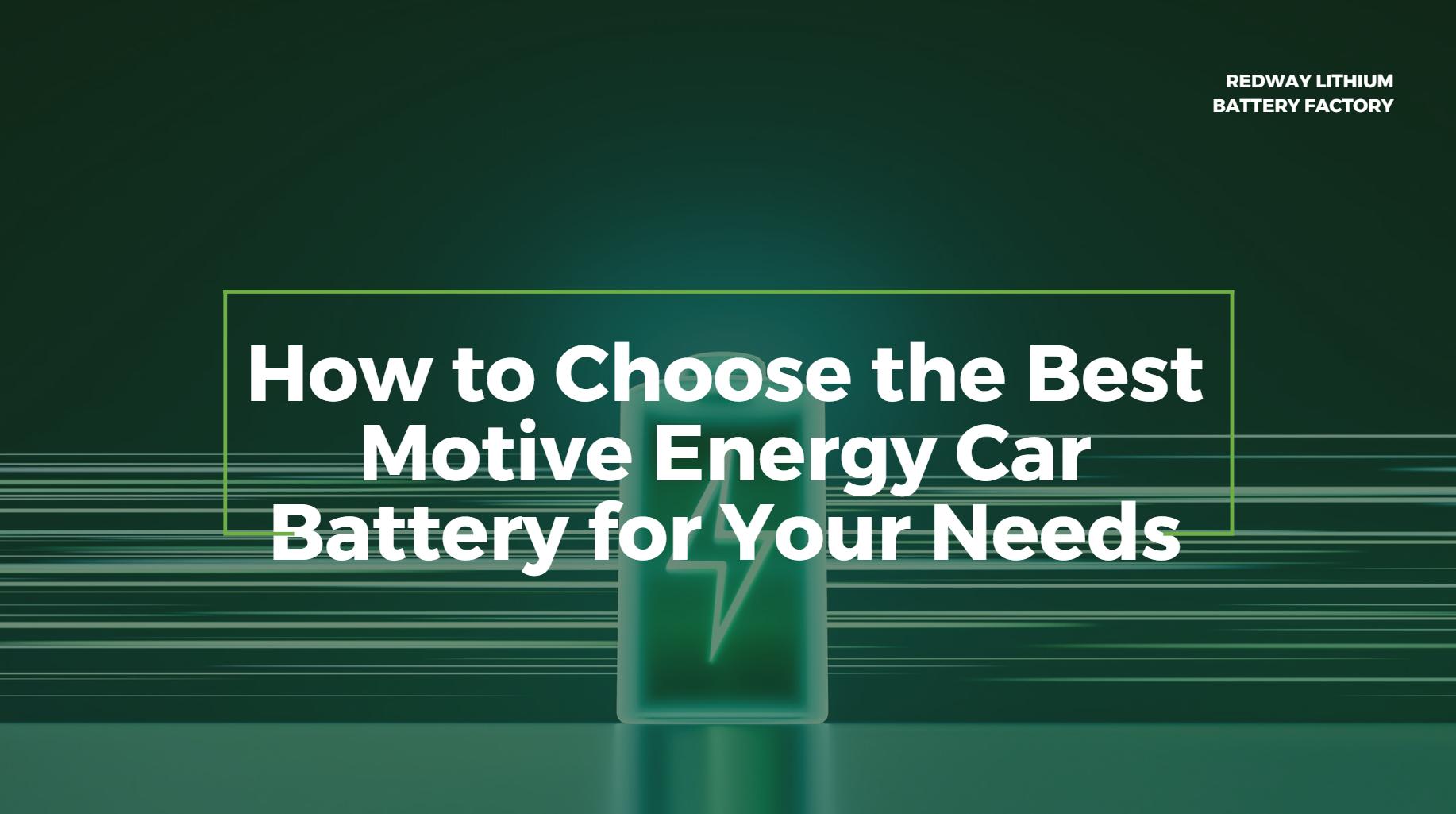
How to Choose the Best Motive Energy Car Battery for Your Needs
Choosing the best motive energy car battery is essential for ensuring reliable power in electric vehicles and other applications. Motive batteries, designed for deep discharge cycles, provide sustained power over extended periods. They come in various types, including lead-acid and lithium-ion, each offering unique benefits tailored to specific needs.
What are motive energy car batteries?
Motive energy car batteries, also known as traction batteries, are specifically designed to power electric vehicles, forklifts, golf carts, and other applications requiring consistent and prolonged energy output. Unlike standard automotive batteries that deliver a quick burst of power to start an engine, motive batteries are built to provide sustained energy over longer durations, making them ideal for electric vehicles.
How do motive batteries differ from standard automotive batteries?
Motive batteries differ from standard automotive batteries in their design and purpose. While standard automotive batteries are primarily used for starting internal combustion engines, motive batteries are built for deep discharge applications, providing sustained power for electric vehicles and heavy-duty equipment. Motive batteries differ from standard automotive batteries in several key ways:
- Design Purpose: Motive batteries are designed for deep cycling and can be discharged significantly without damage, while automotive batteries are intended for short bursts of high current.
- Construction: Motive batteries often use thicker lead plates and more robust designs to withstand repeated charge and discharge cycles.
- Maintenance: Many motive batteries require less maintenance than traditional automotive batteries, especially sealed types that do not need electrolyte refilling.
Chart: Comparison of Motive vs. Standard Automotive Batteries
| Feature | Motive Energy Batteries | Standard Automotive Batteries |
|---|---|---|
| Design Purpose | Sustained power output | Short bursts of power |
| Discharge Depth | Deep discharge capability | Shallow discharge |
| Maintenance | Low or no maintenance | Regular checks needed |
What types of motive energy batteries are available?
Available types of motive energy batteries include lead-acid (flooded and sealed), lithium-ion, and gel batteries. Each type offers unique benefits, such as lithium’s longer lifespan and faster charging times compared to traditional lead-acid options. There are several types of motive energy batteries:
- Flooded Lead-Acid Batteries: These traditional options require regular maintenance but are cost-effective.
- AGM (Absorbent Glass Mat) Batteries: Sealed and maintenance-free, AGM batteries offer better performance and durability.
- Lithium-Ion Batteries: The latest technology providing high efficiency, longer lifespan, and low maintenance requirements.
Chart: Types of Motive Energy Batteries
| Type | Lifespan | Maintenance | Weight | Cost |
|---|---|---|---|---|
| Flooded Lead-Acid | 4-8 years | High | Heavy | Low |
| AGM | 4-7 years | Minimal | Moderate | Medium |
| Lithium-Ion | 5-10 years | Very Low | Light | High |
Why is it important to choose the right battery for your vehicle?
Choosing the right battery is crucial for ensuring compatibility with your vehicle’s power requirements and operational needs. The correct battery type enhances performance, maximizes efficiency, and prolongs the lifespan of both the battery and the vehicle. Selecting the right battery is crucial because it affects your vehicle’s performance, reliability, and overall efficiency. A properly matched battery ensures:
- Optimal Performance: The right battery type provides adequate power for your vehicle’s needs.
- Longevity: Choosing a high-quality battery can extend its lifespan and reduce replacement frequency.
- Safety: Using a compatible battery minimizes risks such as overheating or failure during operation.
How can you maintain your motive energy battery for optimal performance?
To maintain your motive energy battery, regularly check fluid levels (for lead-acid types), keep terminals clean, and ensure proper charging practices. Following manufacturer guidelines for usage and storage will help optimize performance and extend the battery’s lifespan. Proper maintenance is essential to ensure the longevity and efficiency of your motive energy battery:
- Regular Charging: Recharge after each use or when the battery drops below 50% capacity.
- Check Water Levels: For flooded lead-acid types, regularly check and refill electrolyte levels.
- Clean Terminals: Keep terminals free from corrosion to ensure good electrical connections.
- Temperature Management: Store in a cool, dry place to prevent damage from extreme temperatures.
Industrial News
The market for motive energy car batteries is evolving rapidly as electric vehicles become more prevalent. Innovations in lithium-ion technology are making these batteries more efficient and affordable compared to traditional lead-acid options. As manufacturers focus on sustainability and performance improvements, consumers can expect enhanced choices that cater to various needs and budgets.
Expert Views
“Choosing the right motive energy battery is critical for any electric vehicle owner,” states an industry expert. “Lithium-ion technology offers significant advantages in terms of weight and lifespan compared to traditional lead-acid options.” This perspective emphasizes the importance of evaluating both immediate costs and long-term benefits when selecting a battery type.Frequently Asked Questions
- What is the average lifespan of a motive energy battery?
A: Lifespans vary; flooded lead-acid lasts about 4-8 years, while lithium-ion can last up to 10 years. - Are AGM batteries worth the extra cost?
A: Yes, they offer longer lifespans and require less maintenance compared to flooded lead-acid options. - How often should I charge my motive energy battery?
A: Recharge after every use or when it drops below 50% capacity. - Can I mix different types of motive energy batteries?
A: It’s not recommended as different types have different charging requirements and discharge characteristics.
